September made her grand entrance yesterday in magnificent fall regalia: a cloud-studded cape of burnished gold and azure blue.
(Images taken in Brooklin, Maine, on September 1, 2022.)
JOURNAL
September made her grand entrance yesterday in magnificent fall regalia: a cloud-studded cape of burnished gold and azure blue.


(Images taken in Brooklin, Maine, on September 1, 2022.)
August is high summer in Maine, the Nation’s self-appointed “Vacationland.” This year, it often was a time of stampeding clouds in blue skies over fall-colored landscapes and waters that reflected the days’ moods.




That’s not to say that there was no foul weather. However, there wasn’t much and it wasn’t enough to relieve the abnormally dry state of our fields, streams, and woods.



Nonetheless, the shaded light in the August woods sometimes was exquisite, especially when it found a hidden masterpiece.


Some fruits started appearing or ripening in August. The apples on the ancient “wild” apple trees got to an edible size for those who like very tart fruit. For those who like their fruit sweet and tangy, ripe wild blackberries first appeared in August.


The viburnum berries and highbush cranberries were plentiful and the rose hips on beach rose plants were just getting large enough to pick.



August wild flowers tend to be subdued, with many whites, yellows, and pastel colors. Below, you’ll see this month’s white Queen Anne’s lace with a few yellow tansy sprinkled in; a bluish aster; a white fragrant water lily; pinkish Joe Pye weed; goldenrod, and white daisy fleabane.


In the August gardens, things got more dramatic. Below, you’ll see a pink Japanese anemone, a yellow zinnia, and a red coleus.

As for wildlife, our beautiful (but too plentiful) resident white-tailed deer are always worthy of an August Postcard From Maine.

However, the creatures of major interest this month were some of those that will be migrating south soon or dying off. One is the youngest of three osprey fledglings that was born in June, but seemingly couldn’t fish in August, as her siblings were. She spent much of her time in the family’s otherwise empty nest loudly begging for food until her father came by and dropped a fish at her feet. What she’ll do when daddy migrates south in September is a chilling question.


Speaking of troubles, August was a good month to see monarch butterflies, a threatened species. They began the month as caterpillars and some of them started their migration to Mexico in mid-August.



The eastern black swallowtail butterflies also were quite active in August, but they will not survive the year. Their next generation of caterpillars will create chrysalises in which they’ll overwinter.


On the working waterfront, August was a mean month for our lobster fishermen (male and female). Low distributor prices combined with inflationary costs of operation drove many fishermen to reduce their operations significantly.

Some veteran fishermen quit the season altogether and brought their traps in for storage until next year. (Their season usually extends into December.)


On the other hand, August was a great month for sailing this year. The large windjammers that take tourists on multi-day cruises along the coast seemed especially active.

Angelique

Heritage

J&E Riggin

American Eagle

Victory Chimes
August’s winds often provided thrilling rides for sailors in smaller craft. Seeing them cut through the water on a fine summer’s day is an iconic August sight here.



August also was a time for reflection by Fiona, the catboat, and Ned Ludd, the Caledonia yawl:


Finally, there were times of excited expectation, including when the sun went down on the day before the Annual Eggemoggin Reach Regatta, which always occurs on the first weekend of August:

(All images in these Postcards were taken in Down East Maine during August 2022.)
Here you see June yesterday; she’s the youngest and smallest of Ozzie and Harriet’s three fledglings.

She’s alone in the family nest, as usual; she’s loudly begging for food, as usual, and, the tantrum worked, as usual. Ozzie appeared out of nowhere with a fish, she wiggled her tail and screamed like a young hatchling, and Ozzie dropped the fish beside her:
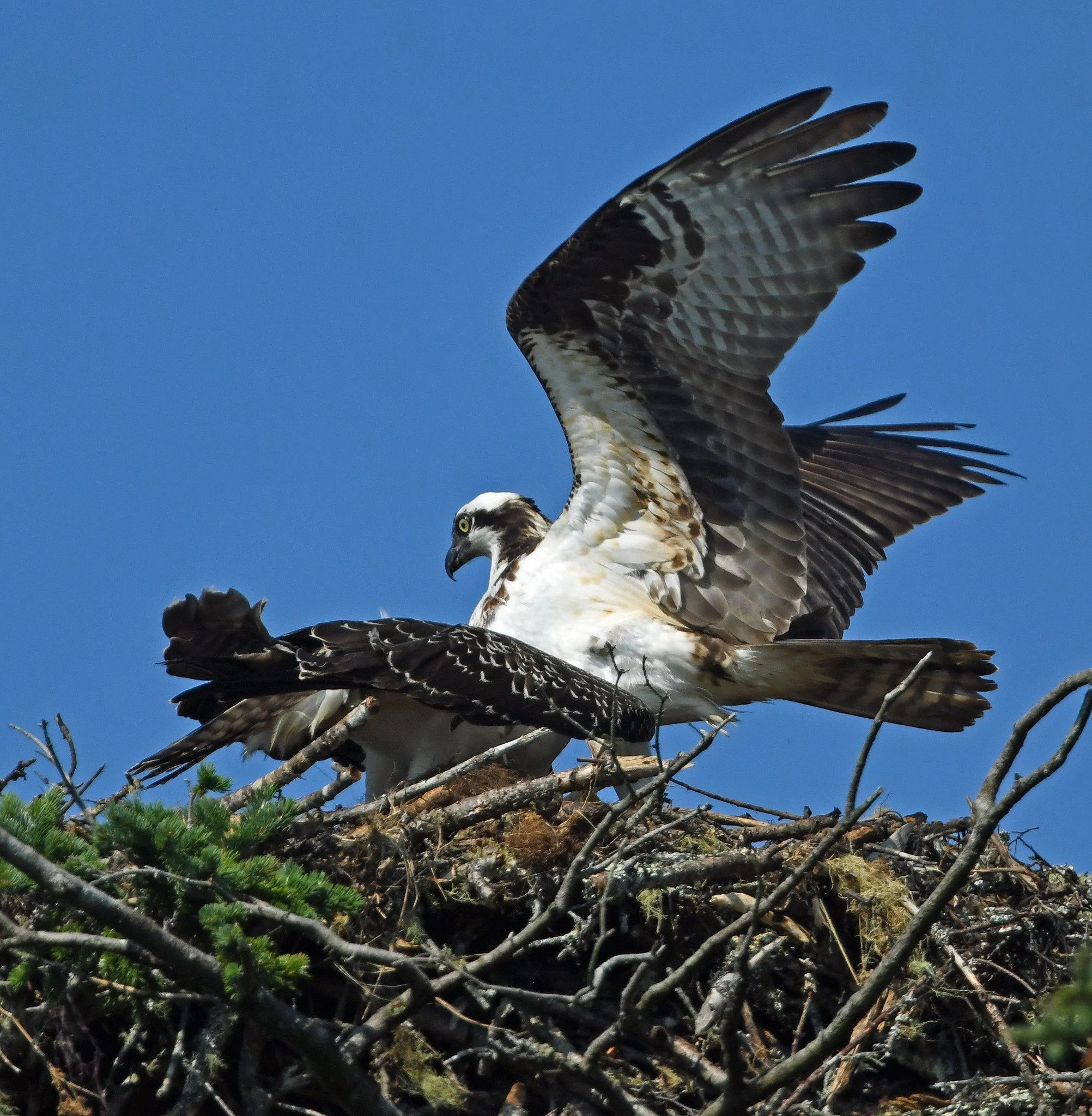
As we have been reporting, this is troubling activity; there is something wrong. June should be learning to fish, as her siblings (David and Ricky) are doing. Ozzie and Harriet always have migrated in mid- to late-September. June will be in significant danger if she doesn’t learn to fish for herself before then. (Images taken in Brooklin, Maine, on August 30, 2022.)
This is Asticou Pond on Sunday afternoon; it’s a focal point for the famous Asticou Azalea Garden on Mount Desert Island. The Garden is at its most tranquil in late August and early September. Now is the time, for those so inclined, to seek peace there by immersing quietly into the Garden’ while its beauty rests.

This period of late summer calm is entirely different from the Garden’s colorful energy in the spring, when seemingly millions of azalea and other rhododendron blooms compete to see which can out-dazzle which. This late-summer time of year also is not like the poignant fall, when the glowing foliage in the Garden makes us finally realize that our love affair with summer is over.




Now, there are only a few plants in bloom in the Garden, just enough to remind us that summer is leaving with a smile. The Japanese anemones seem to say goodbye best:
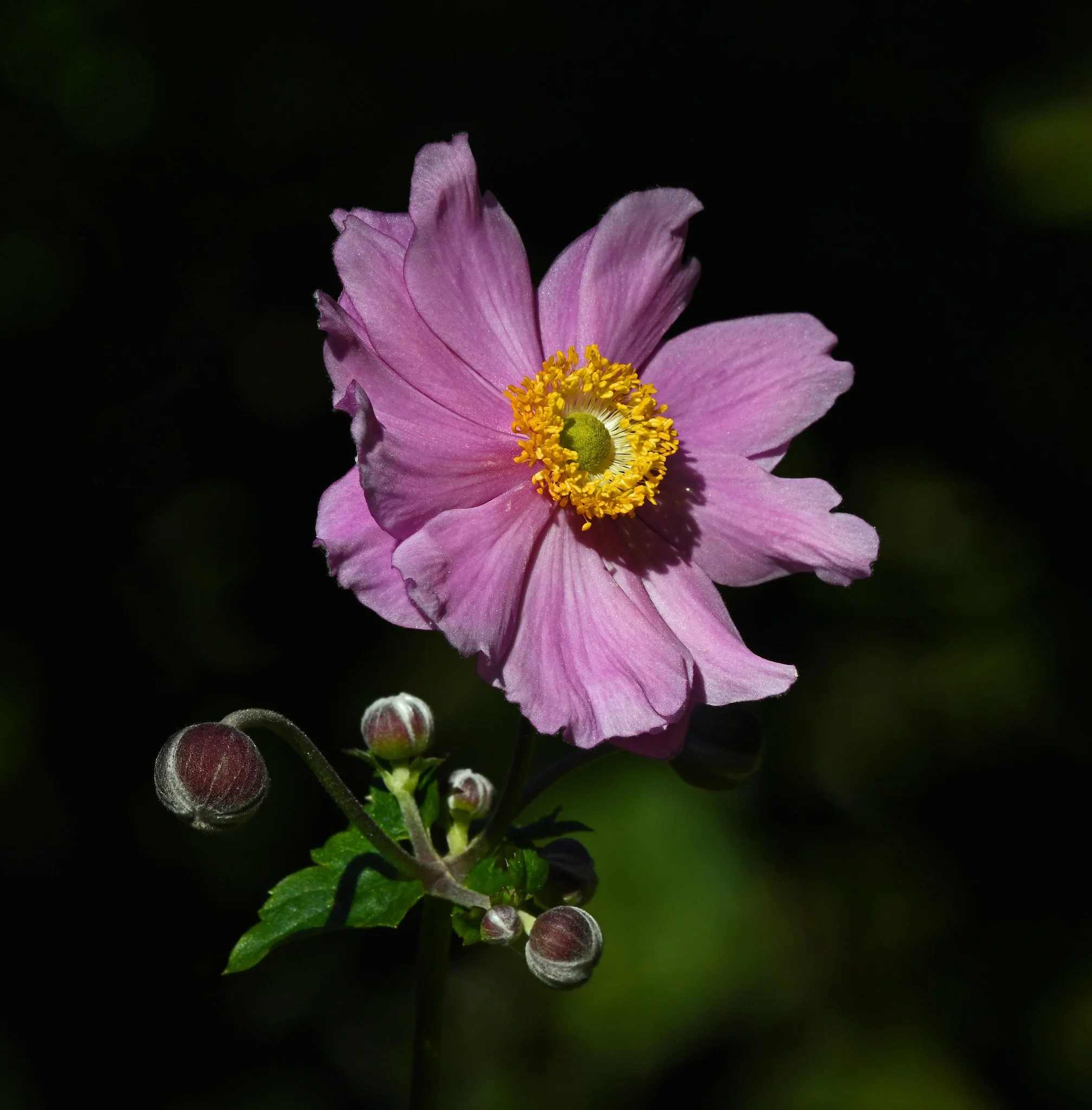
But the fragrant water lilies that are rampant in the Garden’s Lily Pond are a close second:


So, if you are within range, think about visiting the Garden now as well as in the fall. It will be open seven days a week through October 30 from 10 a.m. to 6 p.m. No reservations are needed and no fee is charged, although a contribution of $5.00 per person is asked of those who can afford it.

(Images taken in Northeast Harbor, Maine, on August 28,2022.)
I was lucky to spot this nearly perfect orb web because the sun was behind it yesterday. The web was virtually invisible from the other side.

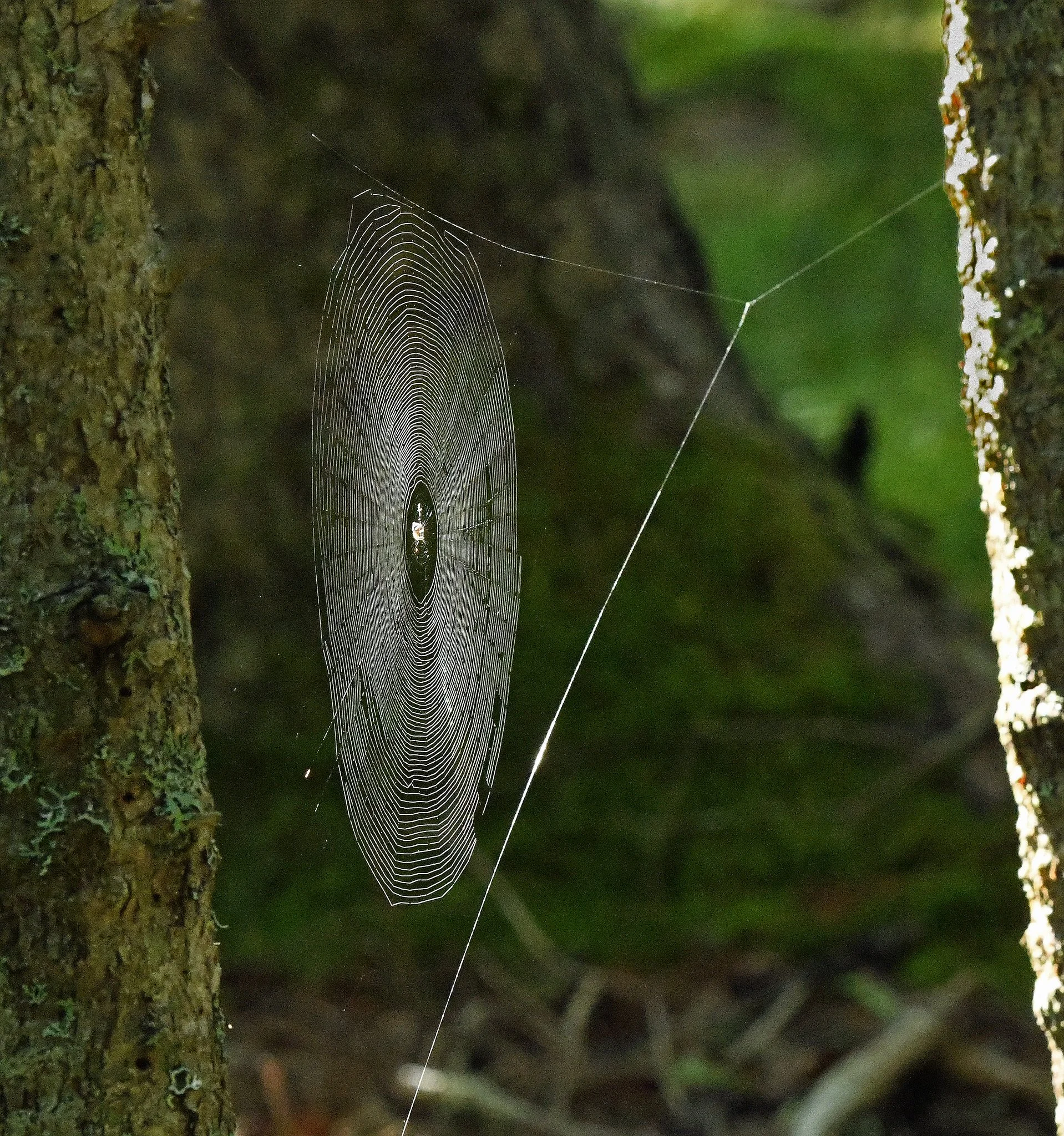
The bad news is that I couldn’t find the orbweaving spider – the Frank (Frances?) Lloyd Wright – that created this masterpiece. I spent half an hour looking in vain at the strands of that web with my glasses on and mosquitoes humming in my ear. The object in the center apparently is wrapped in cobweb silk.
I went back to the website (sic) this morning with some magnifying equipment and found that the beautiful web was a shambles – but, by hanging my handkerchief behind the remainder of the web, I found a small spider-like creature hanging on one of the remaining web anchors:

I haven’t been able to identify that creature; perhaps you can help. It’s about 1/8 inch in size, maybe smaller. The original circular web was about 8 inches in diameter and hung between two trees on the bank of a dry stream bed within fairly heavy mixed woods. The center of the original web was about four feet above the ground. (Images taken in Brooklin, Maine, on August 28 and 29, 2022.)
These are troubling times here. Many lobster fishermen (male and female) are severely limiting the number of days that they go out to fish and some have decided to pull all of their traps and forget about lobster fishing for the rest of this year. Traditionally, the lobster season is ended in December for most fishermen here.
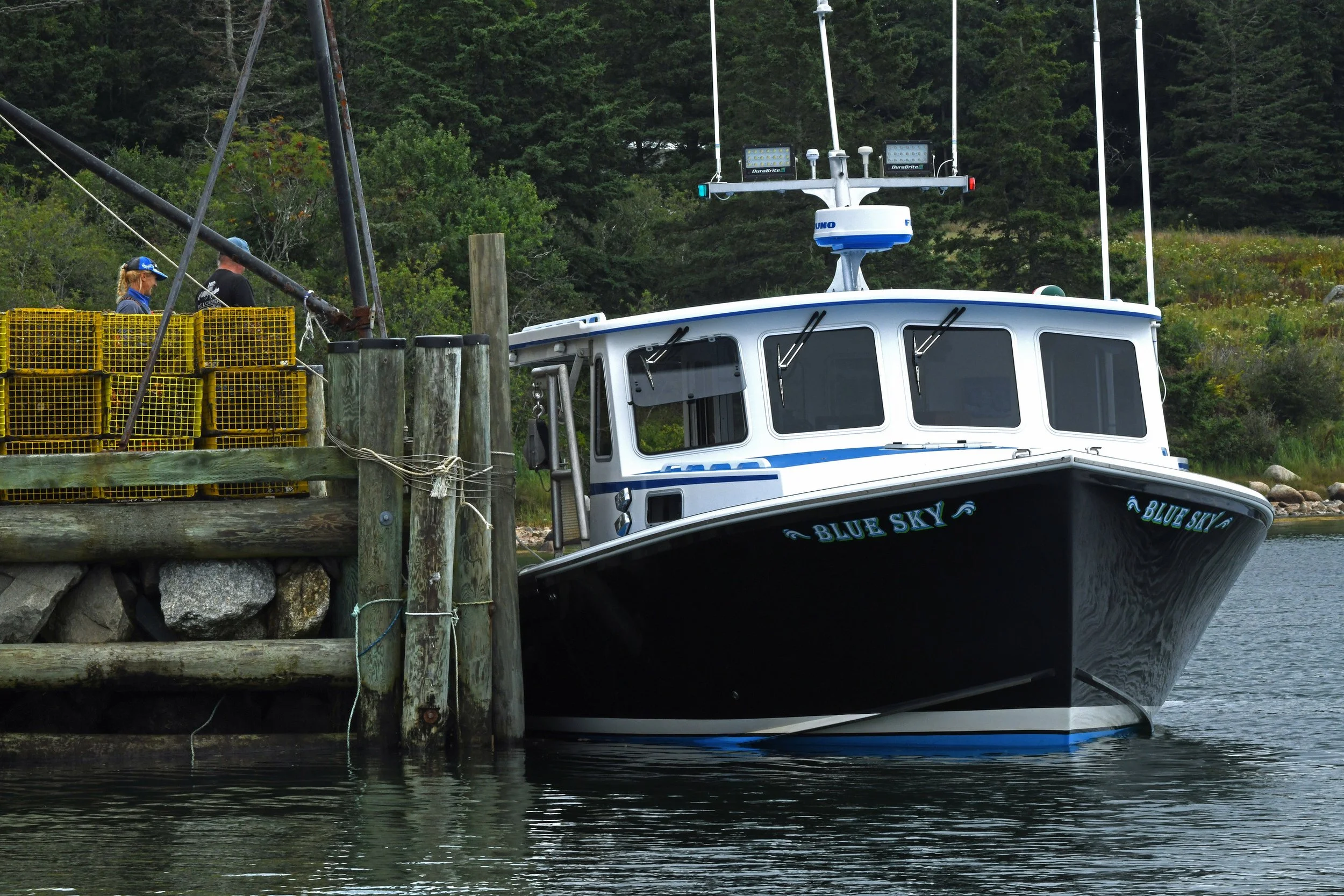
Here you see the lobster traps from the Brooklin Fishing Vessel “Blue Sky” being landed yesterday in Naskeag Harbor. The vessel’s owners, John and Sandy White of Brooklin, have decided to end their season entirely and have pulled all of their traps; they’re storing them on their property until next June.

The low lobster prices being offered by distributors this year have been so out of whack compared to the costs of fishing and maintenance that many find that it’s simply not worth daily fishing trips and, for some, not worth going out at all anymore.

(Images taken in Brooklin, Maine, on August 27, 2022.)
The woods were virtually silent Wednesday as I was trying to pick my way through an off-trail patch. Then, there came some very unwoods-like sounds behind me – “scruch, scrutch, scrutch.” The strange sounds raised in me the involuntary fear that always comes with knowing someone or something is very near and secretly watching. I slowly turned around.

And, there she was: a white-tailed deer that was within 30 feet of me. She also apparently had felt an uncontrollable sensation – probably a stinging bite – which made her instinctively scratch herself and continue to do so as I watched. When she finished scratching, she stood up and looked at me with a “Who-do-you-think-you’re-looking-at?” attitude. Then, she dashed away with a flick of her white tail.

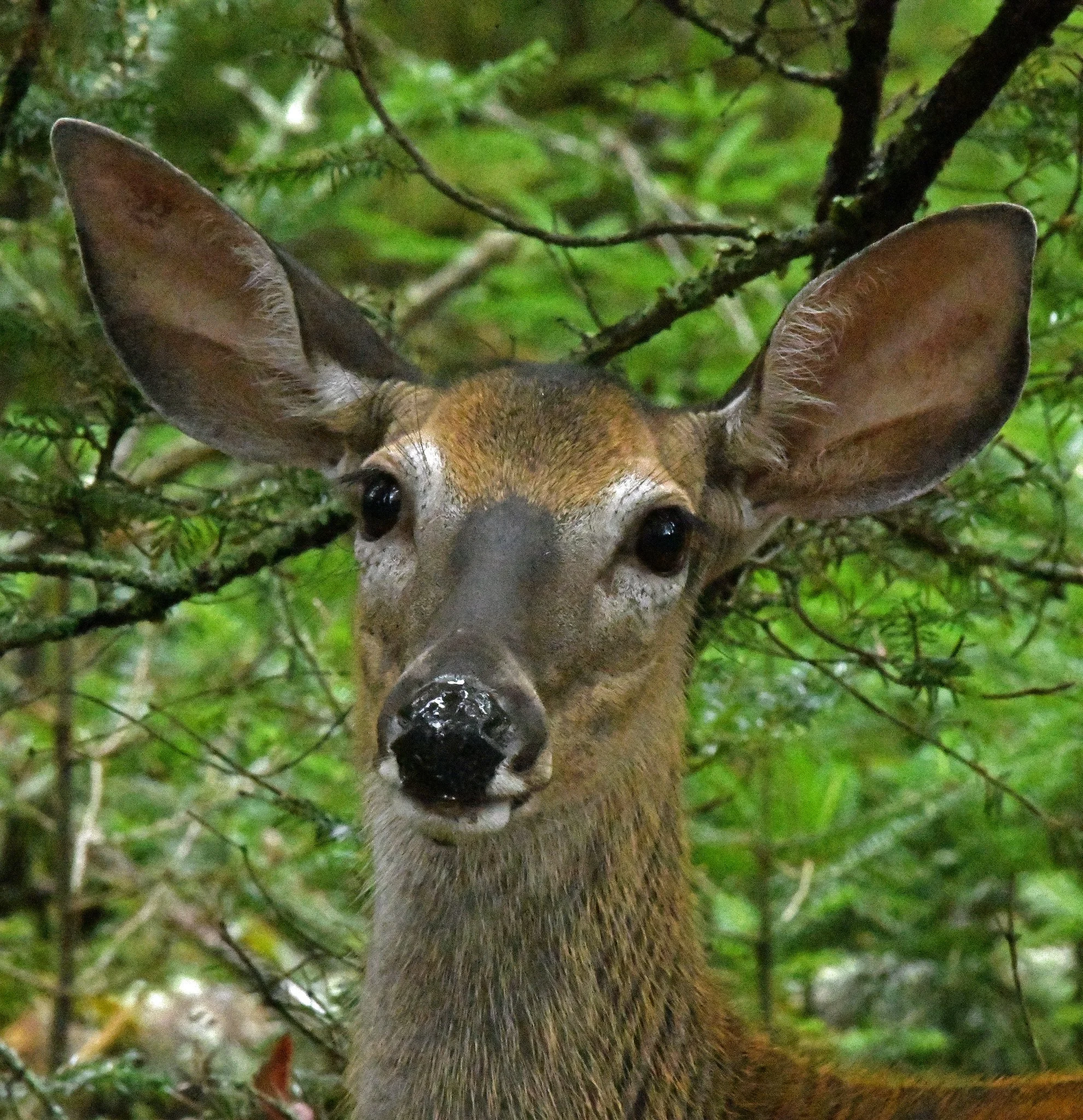
The beauty of these animals makes it easy to forget that they’re cafeterias for hordes of nasty little creatures. Over 100 species of internal and external parasites are known to be hosted by white-tailed deer, including biting insects such as black-legged ticks (“deer ticks,” which are vectors for Lyme disease in humans), bot flies, horse flies, and mosquitoes. (Images taken in Brooklin, Maine, on August 24, 2022.)
I caught this beauty sleeping with her mizzen mast off in Great Cove last week. She’s a Caledonia yawl, part of a worldwide fleet of light, very sailable 19.5-foot double-ended boats designed by Iain Oughtred.
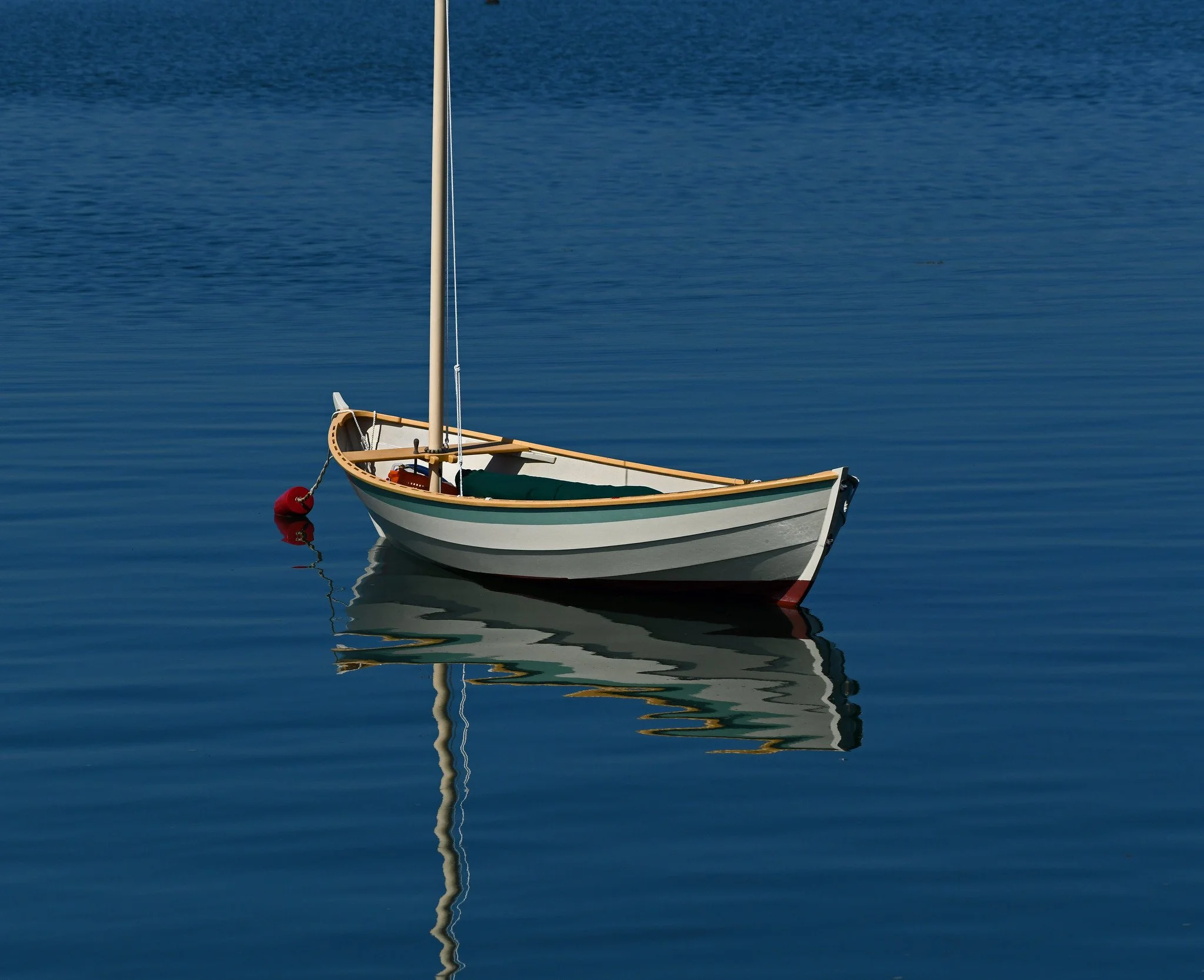
Oughtred, an eminent designer of plans for home boatbuilders, was born in Australia, but migrated to Scotland to do some of his best work. The design for his Caledonias was inspired by traditional Scottish boats that, in turn, were created under the influence of old Scandinavian designs. (“Caledonia,” as you may know, is Latin for Scotland.)
Curiously, the Caledonia shown here is named “Ned Ludd,” after the legendary 19th Century English weaver. Reportedly, Ned Ludd, after being whipped for idleness, became enraged, destroyed machinery, and started a violent movement against the Industrial Revolution. His followers were called “Luddites.”
Ned’s wooden namesake shown here was built by New England boatbuilder Geoff Kerr and launched in 1994. She’s been a familiar sight sailing around here this summer with her mizzen sail on:
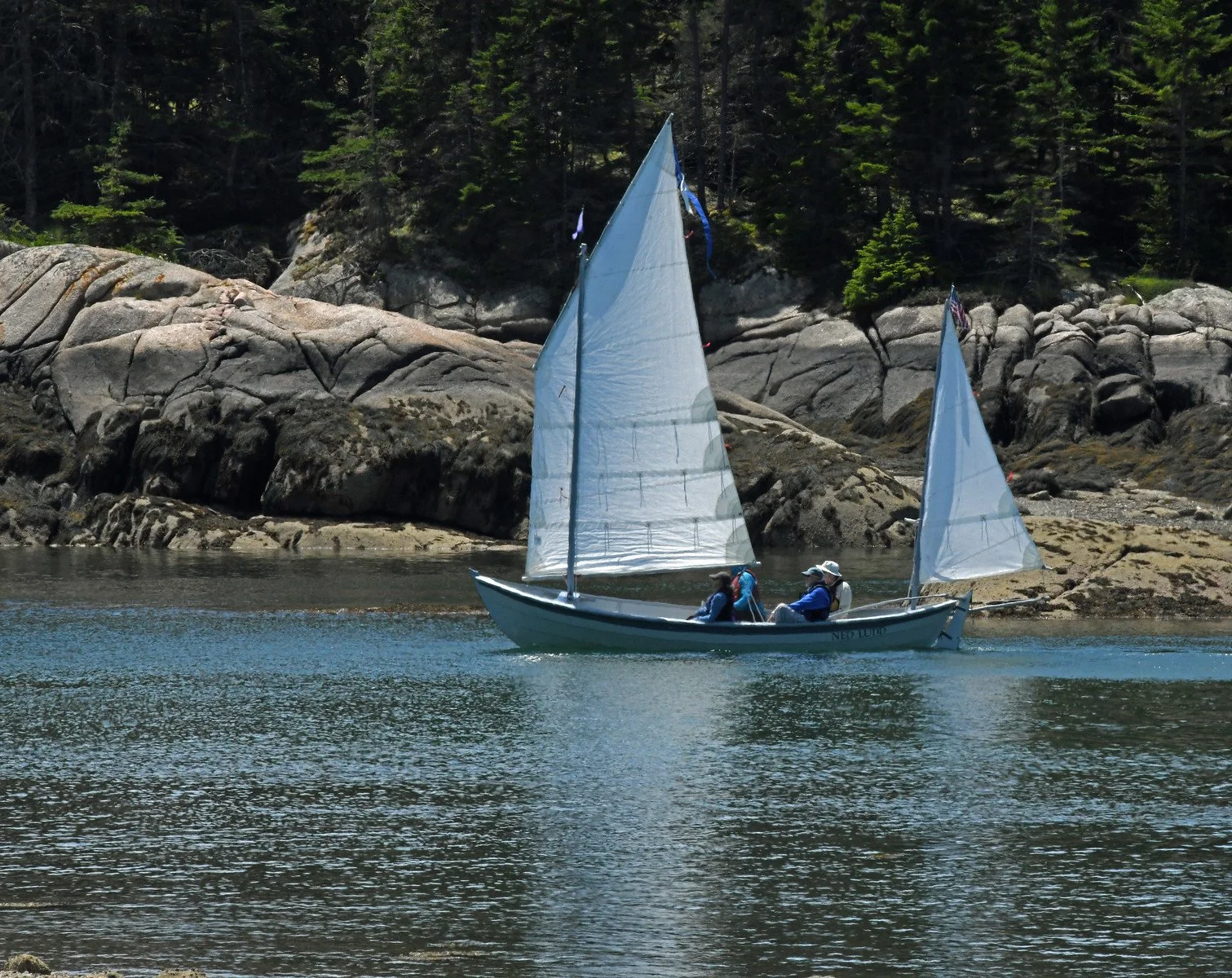
(Images taken in Brooklin, Maine, on August 20 [no sails] and July 7 [sails], 2022.)
Here you see one of our small streams in the woods this morning. It was stone dry for months prior to this week.

Some good rain in Maine during the past week very slightly improved it and other abnormally dry conditions here. As you may be able to see from the image, this mossy-banked stream actually had a trickle of flowing water and one or two small pools containing about half an inch of water. The recent rain even encouraged some mushrooms to emerge and try to sow some seed:
Nonetheless, today’s federal drought report shows that the Maine coast and almost the entire southern half of the State remain abnormally dry, in moderate drought, or in extreme drought as of Tuesday’s data:

The harm that this dryness has been doing is difficult to assess. What it will do to New England’s fall foliage and the tourism thereof is one of the questions to be pondered. (Photographs taken in Brooklin, Maine, on August 24 [mushrooms] and 25 [stream], 2022.)
Below you’ll see a troubling image. It’s shows the youngest and smallest of Ozzie and Harriet’s osprey fledglings, whom I assume (for narration) is a female named June. She’s alone in the family nest and has just dropped into a severe defensive crouch – an overreaction to an unrelated osprey that was flying so high above that I could barely see it.

After the stranger disappeared, she rose and began to eat a fish that Ozzie had brought to the nest, as he has done regularly since his offspring were born:
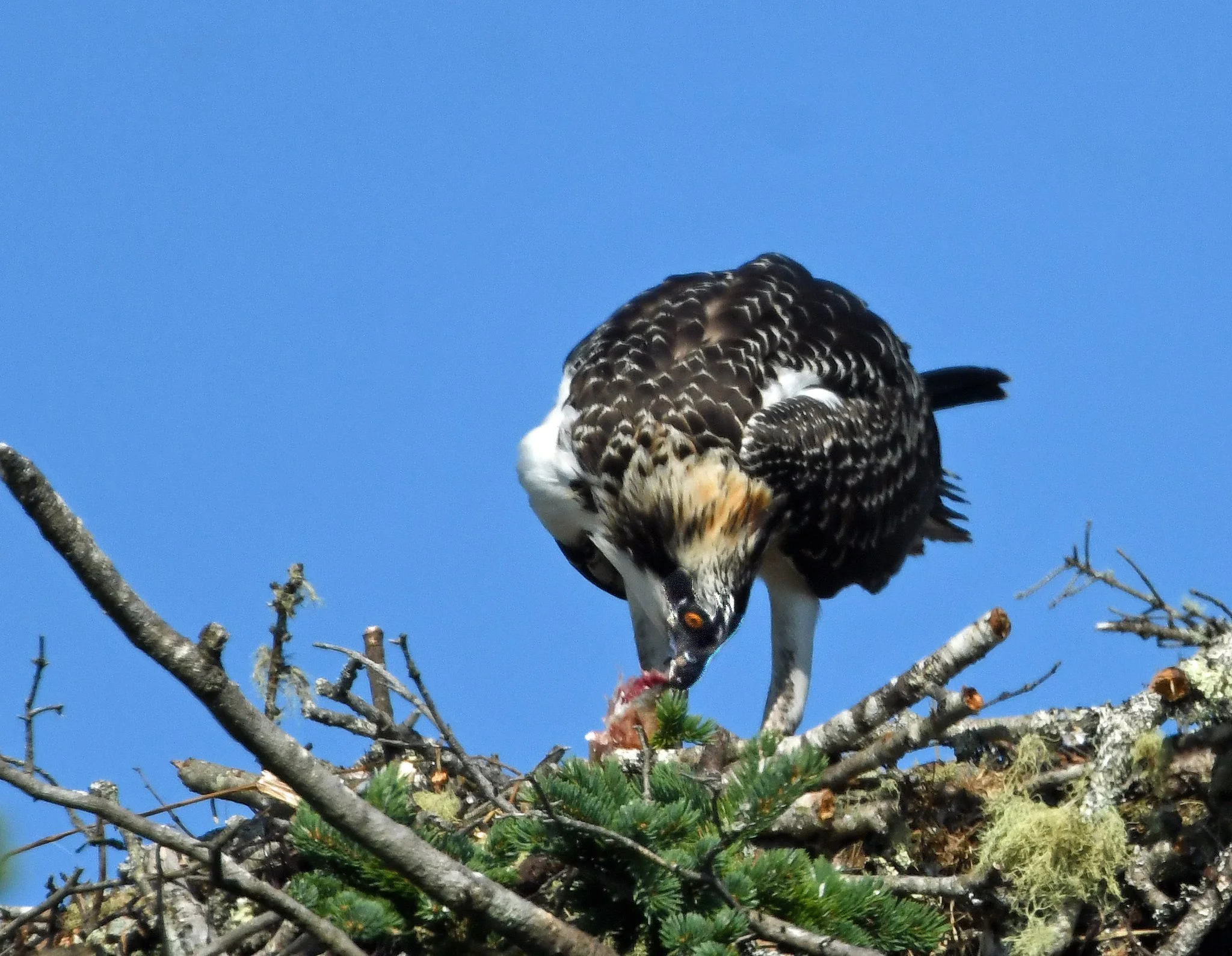
While she was growing, June was bullied by her two older and larger siblings, David and Ricky (names and sexes also assumed). At feeding time, her siblings would edge her out and spar for the food in Harriet’s beak. She got fed when they were sated.
Perhaps this is just the predators’ way of assuring survival of healthy and hearty birds. (There are reports of older osprey fledglings attacking and forcing younger siblings out of the nest during lean times.) There also is a possibility that something is wrong with June that I can’t perceive.
June can fly well, but seems to prefer spending time alone in the family nest while her siblings are out over Great Cove learning from their father the tricky business of plunge-diving for fish. I urgently hope to see her fishing successfully soon because Ozzie and Harriet always have migrated south in September.
Osprey migration in Maine reportedly begins in August, peaks in September, and straggles into November. During migration, the birds have to provide for themselves. It’s a rare osprey that overwinters here, but perhaps June will become one of those rarities that delight birders. However, whether she stays or migrates, June soon will have to learn to fish for herself, if she is to survive. (Images taken in Brooklin, Maine, on August 20, 2022.)
Here’s the schooner “J&E Riggin” in Great Cove at dawn on Sunday. Her mainsail was up to smooth out the effects of winds and tides and her temporary tarpaulin awning was raised to provide shade until she took off a few hours later.

This sleek windjammer from Rockport, Maine, was launched originally in 1927 as an oyster dredger. She’s long, low, and slim for a vessel of 61 gross tons.
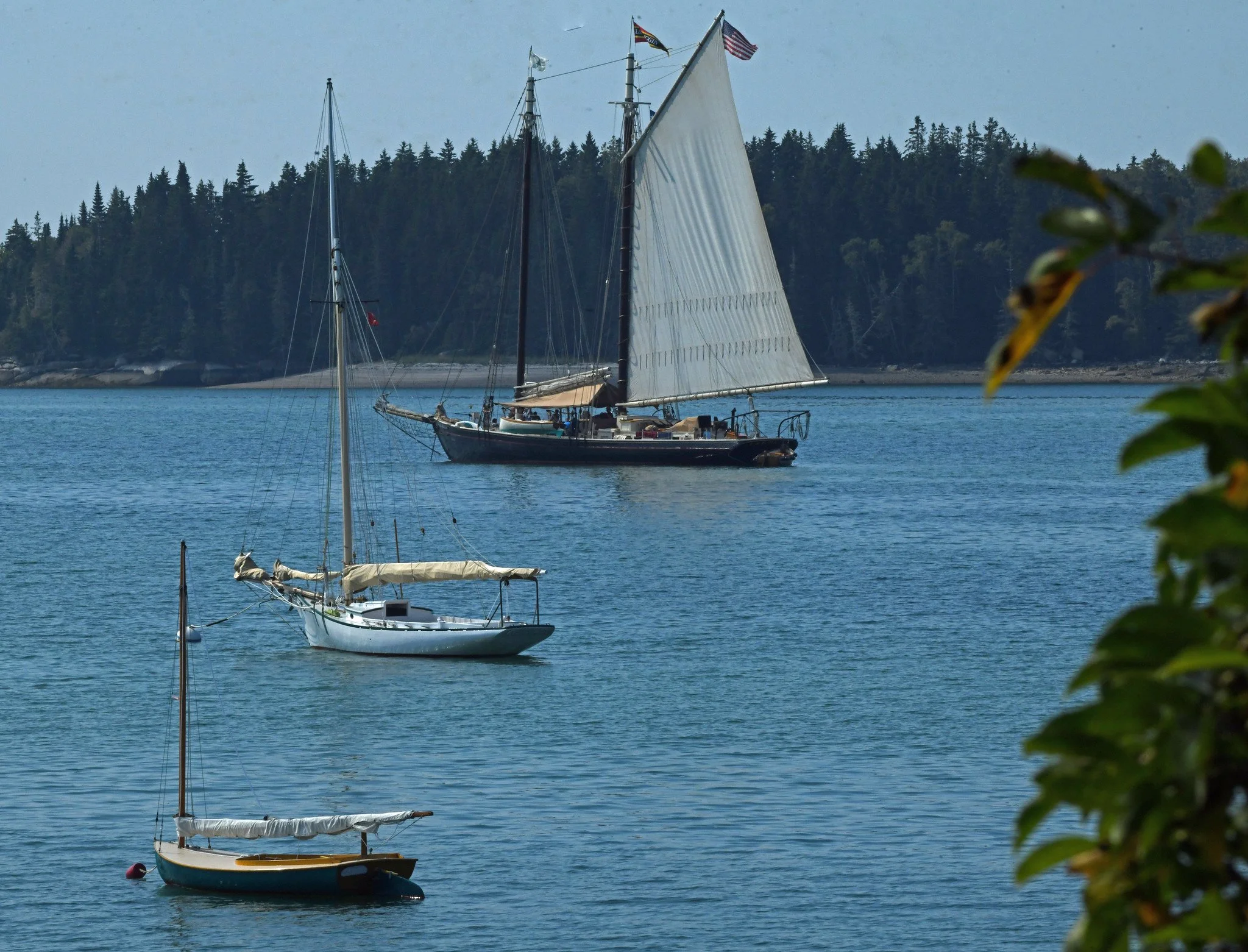
More specifically, the Riggin reportedly is 120 feet long overall; draws only 7 feet of water without centerboard; her deck is close to the surface (for hoisting shellfish, remember), and she’s only 23 feet wide at her widest point (beam). Here she is departing the Cove:


(Images taken in Brooklin, Maine, on August 21, 2022.)
Wild highbush cranberry fruit are starting to appear here on time, which is reassuring. This historic native of Maine and Canada actually is a viburnum (Viburnum trilobum). However, it also is commonly called American cranberrybush and, in Maine’s north woods logging camps, the plant was known as “crampbark” because its bark was used in a cooks’ concoction to relieve muscle cramps.

Those luscious-looking fruit are not cranberries; this plant is from the honeysuckle family. Nonetheless, the fruit look like cranberries and, when properly prepared, provide very tasty and tangy jams and sauces.

Henry David Thoreau, describing his travels in Maine’s woods with two companions, reported that, “notwithstanding their seeds, we all three found them equal to the common cranberry.” (Many recipes for highbush cranberry fruit apparently call for removing their seeds first.) (Images taken in Brooklin, Maine, on August 21, 2022.)
Here you see the schooner “Heritage” at dawn yesterday in Great Cove and a few hours later:



She was pushed by her yawl boat out of the Cove – there was no “air” and she has no motor.. (No motor means more cabin space for tourists.)


The “Heritage” hails from Rockland, Maine, and is one of our largest schooners; she’s 145 feet long counting bowsprit with a 24-foot beam (widest part). She’s also advertised as our “newest” coastal cruiser, having been built in 1983 for the tourist trade. (Images taken in Brooklin, Maine, on August 20, 2022.)
Here you see the busy “convenience raft” in the middle of Naskeag Harbor yesterday afternoon. You also see that lobster boats come in various shapes and sizes, but usually have a significant “sheerline” that sweeps from a high, flared bow for breaking waves to a stern that is low for hoisting traps.

That’s Blue Sky on the left approaching the raft, where Jack Black and white-hulled Sea Princess are moored. Fishermen can buy fuel and bait at the raft when going out in the morning and then sell their catch there on return. Jack is the provisioning boat owned by the raft’s enterprisers.
Sadly, we’re told that this year’s season continues to be a disappointment for fishermen due to low lobster prices and significant costs of operation. (Image taken in Brooklin, Maine, on August 19, 2022.)
Common blackberries here are starting to ripen into high-summer delicacies for outdoor hikers who don’t mind consuming unwashed fruit. (The dark ones shown here were scrumptious.)

These wild brambles also are known as Allegheny blackberries, as their scientific name indicates (Rubus allegeniensis). They are members of the rose family and native to eastern and central North America.
Common blackberries on the vine often are difficult for the casual observer to differentiate from their rose family cousins, black raspberries, which grow in the east as Rubus occidentalis and along the west coast as R. leucodermis.
However, after a berry is plucked, anyone easily can see if its center is hollow like a thimble (a raspberry) or “corked” like a jug (a blackberry – think “blocked berries”):

Leighton Archive Image
(First image taken in Brooklin, Maine, on August 13, 2022.)
Long-tailed ducks are rare on the Down East coast in summer, the experts say. Yet, here you see what appear to be two adults and an immature member of that species resting near the shore of Patten Bay Tuesday:

Here is that apparent juvenile in the water before it flew onto that rock:

This species of sea diving duck is perhaps most famous for being at the center of a socially-sensitive birder controversy in the 19th Century. For hundreds of years, these birds were called “old-squaw ducks” in the United States. This was expressly because the ducks can be extremely loud and garrulous in a group, making their original name-givers think of old Native American women when they got together. Thereafter, as Forbush points out, some birders (whose gender may be inferred) also called them “old wife ducks.”
Finally, in 2000, the American Ornithologists Union, our official bird name-designators, submitted to the pressure and changed the name to what Europeans called the birds: “long-tailed ducks” (Clangula hyemalis).
Here, you see the long-tails’ rest being disturbed by a pair of loquacious immature common mergansers:

Thankfully, long-tails don’t care what mergansers or humans say about them. They go on apparently spending more time under water than any of our other diving duck species, and they are among the deepest divers – they’ve been reported to forage about 200 feet below the water’s surface. (Images taken in Surry, Maine, on August 16, 2022.)
Here you see the high-sterned schooner American Eagle leaving Great Cove last week, flaunting her out-sized mainsail. The Eagle reportedly was the last fishing vessel built in Gloucester, Massachusetts, when she was originally launched in 1930 as the Andrew & Rosalie.

In 1941 after World War II had started in Europe, her name was changed to American Eagle. She stopped fishing in 1983 and underwent thorough reconstructive restoration into a coastal cruiser during 1984-1986.
As she left Great Cove last week, the Eagle passed near the visiting Grayling, which originally was launched in 1915. That older boat spent most of her life as a sardine carrier before being restored and reconstructed into a luxury yacht. I was lucky enough to get the two historic vessels in the same frame:

(Images taken in Brooklin, Maine, on August 13, 2022.)
Here’s a good moment on a high-summer day in Down East Maine:

The temperature is 76 degrees and there’s a slight breeze rippling a fallow field; the wildflowers there – mostly Queen Anne’s lace, goldenrod, tansy, and milk weed – are feeling fall before I do. Stratocumulus clouds are creating animated biblical images overhead. There are no man-made sounds except for my boots on the worn gravel lane, taking me where I want to be. (Image taken in Brooklin, Maine, on August 12, 2022.
Serenity often comes to Naskeag Harbor on windless afternoons just after the turning of low tide, when the light is fading on the slack tide. That’s what you see here:

That’s when fishing vessels seem like pastured work horses that are fenced in by high-water lines on granite. It’s when the boats can point any way they want without being harassed into uniformity by a tide, current, and/or wind.

However, there apparently also is a less pleasing reality now at Naskeag Harbor and other working harbors in Down East Maine. I’m told that the prices that fishermen have been getting for lobsters this season are not keeping up with the increasing costs of fishing for the tasty crustaceans. Those costs include, among others, the cost of fuel, bait, sternmen’s wages, and set-asides for replacement of worn-out equipment.
Let’s hope that the market becomes more realistic before fishermen decide that lobstering this year is not worth the significant effort. (Images taken in Brooklin, Maine, on August 11, 2022.)
All is well with Ozzie and Harriet and their three offspring, which you may remember we named David, Ricky, and (last born and least in size) June. Here you see Harriet yesterday on her windy perch, sternly guarding her nest from the top of a huge spruce that overlooks the family home:


The three fledglings are all flying well and learning to fish. They use their nest as a home base and as a fly-in restaurant. Ozzie continues to deliver fish there for them. Below, you’ll see June and Ozzie in the nest after he brought lunch:

Note that June’s eyes (and those of her siblings) are still red-amber; they won’t turn yellow-golden until sexual maturity in about two to three years:

(Images taken in Brooklin, Maine, on August 13, 2022.)